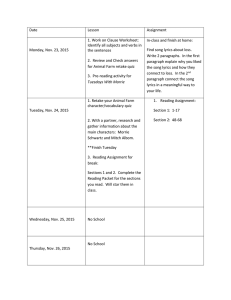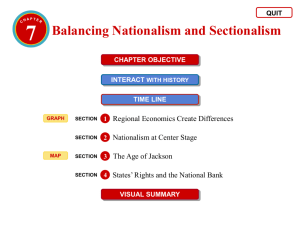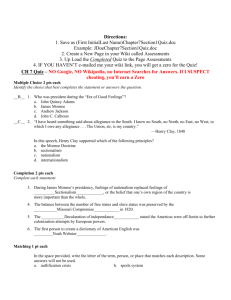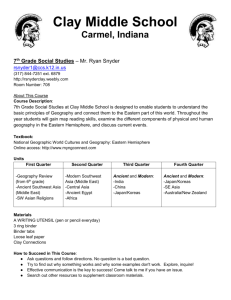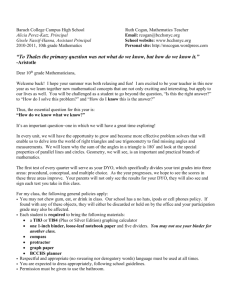Young Republic Unit Guide
advertisement
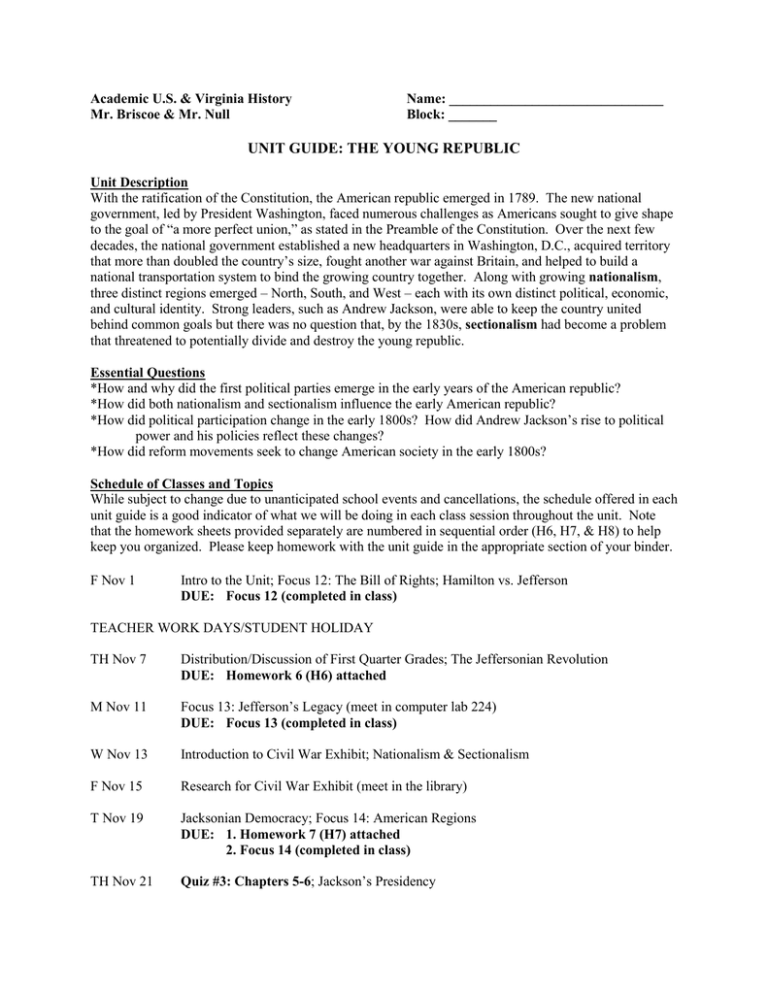
Academic U.S. & Virginia History Mr. Briscoe & Mr. Null Name: _______________________________ Block: _______ UNIT GUIDE: THE YOUNG REPUBLIC Unit Description With the ratification of the Constitution, the American republic emerged in 1789. The new national government, led by President Washington, faced numerous challenges as Americans sought to give shape to the goal of “a more perfect union,” as stated in the Preamble of the Constitution. Over the next few decades, the national government established a new headquarters in Washington, D.C., acquired territory that more than doubled the country’s size, fought another war against Britain, and helped to build a national transportation system to bind the growing country together. Along with growing nationalism, three distinct regions emerged – North, South, and West – each with its own distinct political, economic, and cultural identity. Strong leaders, such as Andrew Jackson, were able to keep the country united behind common goals but there was no question that, by the 1830s, sectionalism had become a problem that threatened to potentially divide and destroy the young republic. Essential Questions *How and why did the first political parties emerge in the early years of the American republic? *How did both nationalism and sectionalism influence the early American republic? *How did political participation change in the early 1800s? How did Andrew Jackson’s rise to political power and his policies reflect these changes? *How did reform movements seek to change American society in the early 1800s? Schedule of Classes and Topics While subject to change due to unanticipated school events and cancellations, the schedule offered in each unit guide is a good indicator of what we will be doing in each class session throughout the unit. Note that the homework sheets provided separately are numbered in sequential order (H6, H7, & H8) to help keep you organized. Please keep homework with the unit guide in the appropriate section of your binder. F Nov 1 Intro to the Unit; Focus 12: The Bill of Rights; Hamilton vs. Jefferson DUE: Focus 12 (completed in class) TEACHER WORK DAYS/STUDENT HOLIDAY TH Nov 7 Distribution/Discussion of First Quarter Grades; The Jeffersonian Revolution DUE: Homework 6 (H6) attached M Nov 11 Focus 13: Jefferson’s Legacy (meet in computer lab 224) DUE: Focus 13 (completed in class) W Nov 13 Introduction to Civil War Exhibit; Nationalism & Sectionalism F Nov 15 Research for Civil War Exhibit (meet in the library) T Nov 19 Jacksonian Democracy; Focus 14: American Regions DUE: 1. Homework 7 (H7) attached 2. Focus 14 (completed in class) TH Nov 21 Quiz #3: Chapters 5-6; Jackson’s Presidency M Nov 25 Focus 15: Revivalism and Transcendentalism; Antebellum Reform (Part I) DUE: Homework 8 (H8) attached THANKSGIVING BREAK M Dec 2 Antebellum Reform (Part II); Unit Review W Dec 4 Unit Test: The Young Republic (60 minutes); Quiz #3 Retake (20 minutes) Focus 15: Regional Geography: The South DUE: 1. Review all unit materials for the unit test (see below) 2. Binder check (in class during the test) Unit Test (20% of quarter grade) The unit test on December 4 will consist of a mix of objective and written sections as follows: *Key Terms (30%) – 15 items, fill in the blank to complete a sentence, word bank provided *Chronology (5%) – place five events in order from oldest to most recent *Biography (10%) – 5 items, fill in the blank; word bank provided *Geography (5%) – 5 items, match terms to locations on a map *Matching (10%) – 10 items, match descriptions to political parties/Supreme Court cases *Primary Source Analysis (20%) – answer a question related to primary sources *Short Essay (20%) – answer a question related to unit content, choices provided Completing the unit guide reading and homework assignments, as well as all in-class activities, will help prepare you for the unit test. Quarter Exhibit: The Civil War The quarter exhibit will be introduced in class on November 13. Students will each have their own individual research topic. The exhibit constitutes 20% of your quarter grade. All exhibits are due by Wednesday, December 18. Homework The readings and homework will help introduce you to the unit content and will also prepare you for each class. The vocabulary and questions will also help prepare you for the quiz and especially for the unit test. Homework will be checked during the indicated class session for a homework credit. Incomplete homework will receive a percentage grade (25, 50, or 75) or will be marked in Clarity with a “Z” (meaning a zero for an assignment that was not attempted). At the end of the unit, the unit guide will be turned in as part of the unit binder check. At that time, any homework or focus grade that was less than 100% (or even a “Z”) can be adjusted up to 100% if the work has been subsequently completed. Important Note on Retake Testing Unit guides are critical for the retake process. Homework in the unit guide and relevant focus activities and class notes must be completed prior to any retake opportunity. The unit guide and focus activities serve as good evidence that you have done your part to prepare for a quiz or test both in and outside of class time. For example, in order to retake Quiz 3 on Wednesday, December 4, you would need to have completed Homework 6, as well as Focus 12 and Class Notes 12, 13, and 14. If those are not completed by the start of the retake, the retake opportunity is missed and cannot be made up. Academic U.S. & Virginia History Mr. Briscoe & Mr. Null Name: _______________________________ Block: _______ HOMEWORK 6 (H6) – Young Republic Please complete the following for the start of class on Thursday, November 7: 1. Read Ch. 6, “Launching the New Nation” (all) 2. Complete the vocabulary and questions below. Feel free to write out your answers on notebook paper if you need more room. Vocabulary Term Cabinet Alexander Hamilton Bank of the U.S. two-party system protective tariff Whiskey Rebellion neutrality Jay’s Treaty sectionalism What/who is it? Significance in U.S. history? XYZ Affair Alien & Sedition Acts nullification Lewis & Clark Louisiana Purchase John Marshall judicial review Short Response What were two major causes of the War of 1812 between the United States and Great Britain? Consider issues on land and sea. (see pp. 202-203) _____________________________________________________________________________________ _____________________________________________________________________________________ _____________________________________________________________________________________ _____________________________________________________________________________________ _____________________________________________________________________________________ _____________________________________________________________________________________ _____________________________________________________________________________________ _____________________________________________________________________________________ Academic U.S. & Virginia History Mr. Briscoe & Mr. Null Name: _______________________________ Block: _______ HOMEWORK 7 (H7) – Young Republic Please complete the following for the start of class on Tuesday, November 19: 1. Read Ch. 7, “Balancing Nationalism & Sectionalism” (all) 2. Complete the vocabulary and questions below. Feel free to write out your answers on notebook paper if you need more room. Vocabulary Term Eli Whitney (link to cotton gin and interchangeable parts) mass production Industrial Revolution Henry Clay’s “American System” Erie Canal McCulloch v. Maryland (1819) nationalism Adams-Onis Treaty Monroe Doctrine What/who is it? Significance in U.S. history? Missouri Compromise Andrew Jackson spoils system Indian Removal Act Trail of Tears Tariff of Abominations Short Response In your opinion, was Andrew Jackson a great president? Consider his actions with regard to Indian removal, the South Carolina nullification crisis, and his “war” on the Bank of the United States. _____________________________________________________________________________________ _____________________________________________________________________________________ _____________________________________________________________________________________ _____________________________________________________________________________________ _____________________________________________________________________________________ _____________________________________________________________________________________ _____________________________________________________________________________________ _____________________________________________________________________________________ _____________________________________________________________________________________ _____________________________________________________________________________________ Academic U.S. & Virginia History Mr. Briscoe & Mr. Null Name: _______________________________ Block: _______ HOMEWORK 8 (H8) – Young Republic Please complete the following for the start of class on Monday, November 25: 1. Read Ch. 8, “Reforming American Society” (all) 2. Complete the chart below and on the reverse side. Feel free to write out your answers on notebook paper if you need more room. See the example provided. Movement/Description Second Great Awakening: Major religious revival that swept the nation from the 1790s through the 1840s Transcendentalism: (including Unitarianism) Asylum & Prison Reform Education Reform: Leaders Charles Grandison Finney Richard Allen Impact *encouraged Americans to seek salvation and better themselves and their communities *resulted in camp meetings and the rise of new churches (ex: African Methodist Episcopal) *revivals were characterized by intense emotions Movement/Description Abolitionist Movement: Women’s Rights Movement: Temperance: Worker’s Rights Movement: Leaders Impact

